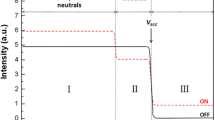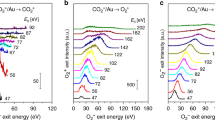Abstract
The unusual and unique ability of O2 as target gas in kV collision-induced dissociations, to enhance a specific fragmentation of a mass selected ion, has been examined in detail. The affected dissociations studied were the loss of CH .3 from CH3CH+X (X = OH, CH3, NH2, SH); CH3 and Cl. loss from CH3C+(Cl)CH3; C2H5 loss from CH3CH2CH+X (X = OH and NH2); H loss from Cl. CH2OH and+CH2NH2; O. loss from 1,2−, 1,3−, and 1,4−C6H4(NO +.2 CH3NO +.2 ; C6H5NO +.2 ; C5H5NO+. (pyridine N-oxide); 3− and 4−CH3C5H4NO+.. A general explanation of the phenomena, which was semiquantitatively tested in the present work, can be summarized as follows: the ion − O2 encounter excites the target molecules to their3∑ − g state which resonantly return this energy to electronic state(s) in the ion. The excited ion now contains a sharp excess of a narrow range of internal energies, thus significantly and only enhancing fragmentations whose activation energies lie within this small energy manifold.
Similar content being viewed by others
References
McLuckey, S. A.J. Am. Chem. Soc. Mass Spectrom. 1992,3, 599.
Baer, T.; Hase, W. L.Unimolecular Reaction Dynamics Theory and Experiments; Oxford University Press: New York, 1996.
Jennings, K. R.Int. J. Mass Spectrom. Ion Phys. 1968,1, 227.
Haddon, W. F.; McLafferty, F. W.J. Am. Chem. Soc. 1968,90, 4745.
Burgers, P. C.; Holmes, J. L.; Mommers, A. A.; Terlouw, J. K.Chem. Phys. Lett. 1983,102, 1.
Danis, P. O.; Wesdemiotis, C.; McLafferty, F. W.J. Am. Chem. Soc. 1983,105, 7454.
For some recent reviews see Goldberg, N.; Schwarz, H.Acc. Chem. Res. 1994,27, 347.
For some recent reviews see Schalley, C. A.; Hornung, G.; Schroder, D.; Schwarz, H.Chem. Soc. Rev. 1998,27, 91.
For some recent reviews see Turecek, K.J. Mass Spectrom. 1998,33, 779.
For some recent reviews see Zagorevskii, D.; Holmes, J. L.Mass Spectrom. Rev. 1999,18, 87.
Flammang, R.; Gallez, L.; Haverbeke, Y. V.; Wong, M. W.; Wentrup, C.Rapid Commun. Mass Spectrom. 1996,10, 232.
Gerbaux, P.; Barbieux-Flammang, M.; Haverbeke, Y. V.; Flammang, R.Rapid Commun. Mass Spectrom. 1999,13, 1707.
Flammang, R.; Gerbaux, P.; Wong, M. W.Chem. Phys. Lett. 1999,300, 183.
Flammang, R.; Henrotte, V.; Gerbaux, P.Eur. Mass Spectrom. 2000,6, 3.
Aubry, C.; Holmes, J. L.J. Phys. Chem. A 1998,102, 6441.
Holmes, J. L.; Mayer, P. M.J. Phys. Chem. 1995,99, 1366.
Bush, K. L.; Glish, G. L.; McLuckey, S. A.Mass Spectrometry/ Mass Spectrometry; VCH: New York, 1988.
Holmes, J. L.; Terlouw, J. K.Org. Mass Spectrom. 1980,15, 383.
Some preliminary low translational kinetic energy experiments deserve mention. As part of a related study in this laboratory, the CID mass spectra of CH3CH+OH ions were recorded at laboratory energies of up to 50 V at which energy extensive fragmentation was observed. Argon and oxygen were essentiallyindistinguishable as target gases, apart from their different cross sections. Thus the unusual behavior of O2 is not observed in simple momentum-transfer encounters.
Hart, W. J. v. d.Int.J. Mass Spectrom. Ion Processes 1995,151, 27.
Burgers, P. C.; Mommers, A. A.; Holmes, J. L.J. Am. Chem. Soc. 1983,105, 5976.
Sumathi, R.; Peyerimhoff, S. D.; Sengupta, D.J. Phys. Chem. A 1999,103, 772.
Lias, S. G.; Bartmess, J. E.; Liebman, J. F.; Holmes, J. L.; Levin, R. D.; Mallard, W. G.J. Phys. Chem. Ref. Data 1988,17, Supp. 1.
Calvert, J. G.; Pitts, J. N.Photochemistry; Wiley: New York, 1966.
Krupeni, P. H.J. Phys. Chem. Ref. Data 1972,1, 423.
Herzberg, G.Atomic Spectra and Atomic Structure; Dover: New York, 1944.
Aubry, C.; Polce, M. J.; Holmes, J. L.; Mayer, P. M.; Radom, L.J. Am. Chem. Soc. 1997,119, 9030.
An, Y. Study of organic cations in the gas phase by tandem mass spectrometry. Ph.D. Thesis, University of Ottawa, 1996.
Rodriguez, C. F.; Böhme, D. K.; Hopkinson, A. C.J. Am. Chem. Soc. 1993,115, 3263.
Polasek, M.; Sadilek, M.; Turecek, F.Int. J. Mass Spectrom. 2000,195/196, 101.
Author information
Authors and Affiliations
Corresponding author
Rights and permissions
About this article
Cite this article
Aubry, C., Holmes, J. The behavior of oxygen as a collision-induced dissociation target gas. J. Am. Soc. Spectrom. 12, 23–29 (2001). https://doi.org/10.1016/S1044-0305(00)00201-4
Received:
Revised:
Accepted:
Issue Date:
DOI: https://doi.org/10.1016/S1044-0305(00)00201-4




